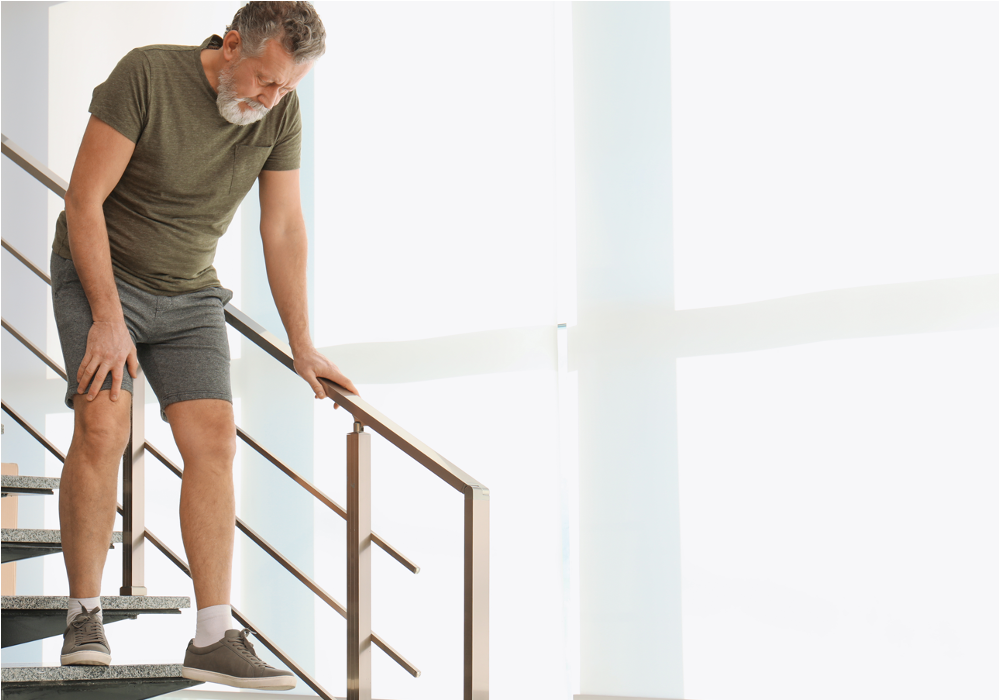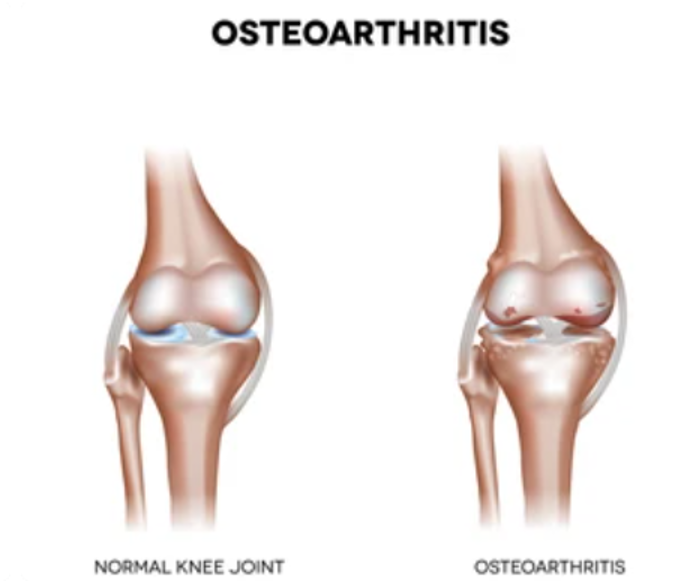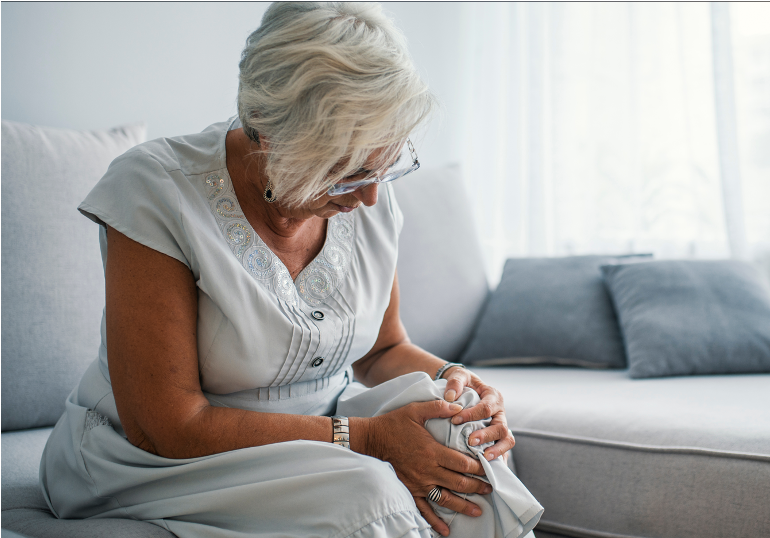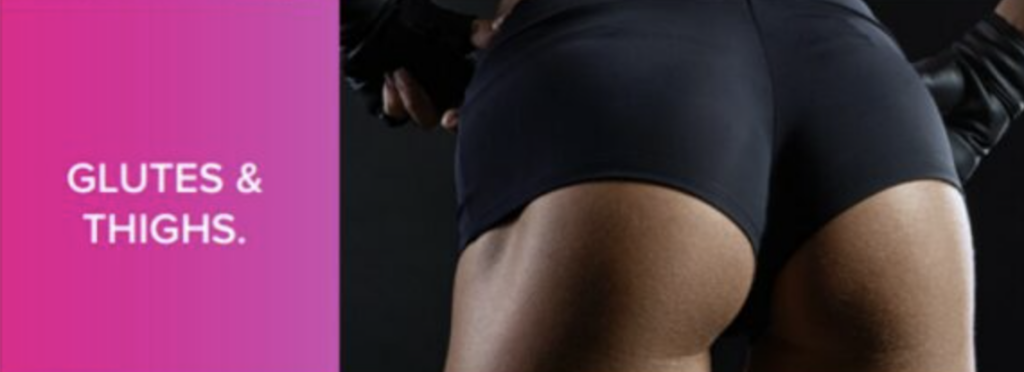PRP Knee Injections
Knee Pain
Knee pain is a common affliction that can be caused by many things, such as age, injury, or arthritis. The knee joint is one of the most commonly affected joints by osteoarthritis. The cartilage in the knee may begin to break down after sustained stress, leaving the bones of the knee rubbing against each other, resulting in osteoarthritis. This can lead to serious effects on one’s mobility, quality of life and livelihood. Pain, swelling and stiffness from loss and damage to the cartilage can make it difficult to walk or climb stairs.


Symptoms of Knee Osteoarthritis
- Creaking and grating (crepitus):You may hear crackling noises or feel a grating sensation
- Instability:Your knee may “give out” or buckle, or feel like it could
- Locking:The knee may lock or stick
- Loss of motion:Over time, you may lose the ability to bend and straighten your knee all the way
- Pain: Aching pain while sitting, movement causes pain
- Stiffness:Stiffness in your knees first thing in the morning or after sitting for long periods of time
- Swelling:Swelling in your knee all around or on one side

Risk Factors of Knee Osteoarthritis
- Age:Most common in older adults, however, it can happen at any age
- Bone deformities:You are at higher risk if you have crooked bones or joints
- Genetics:This can be inherited
- Injuries:Any knee injury, even old ones, can lead to knee Osteoarthritis
- Obesity:Adds stress to your knees, fat cells also make proteins that can cause inflammation in and around your joints
- Repeated stress:Frequent stress on your knee from your job or playing sports can increase your risk
- Sex:Women are more likely to have knee Osteoarthritis than men
- Some metabolic diseases:Diabetes and hemochromatosis, a condition in which your blood has too much iron, have been linked to Osteoarthritis
PRP Knee Injections
If you are suffering from knee pain and have not found relief with traditional treatments or you have been told you need surgery and you would like to avoid or delay it, you may want to consider Platelet-rich plasma (PRP) injections. PRP therapy is a cutting-edge treatment option that enhances natural joint healing with platelets used from your blood cells to help heal your knee.
Your blood is made up of four main components: red blood cells, white blood cells, platelets, and plasma. Platelet-Rich Plasma (PRP) is a concentrated component from your own blood that contains nutrient-rich cells and protein growth factors. Plasma is the liquid portion of your blood, composed of protein, water, and thrombocytes that aid in blood clotting and healing. The process of forming PRP separates your powerful platelets from red blood cells and concentrates them into an injection for healing. When made into an injection, PRP (platelet-rich-plasma) can be used to alleviate joint and muscle pain, sprains, strains, and conditions like osteoarthritis.
A sample of your blood is collected and placed in a centrifuge; it is spun at high speed, allowing the plasma to separate from the red blood cells. The plasma layer is carefully extracted into a syringe and injected into the injured or painful area. The platelets release growth factors into the muscle, joints and other target tissue, encouraging cell repair and renewal. PRP injections trigger and encourage the body’s natural healing process, which is why this treatment falls under the category of regenerative medicine. PRP injections are a great choice for those looking for minimally-invasive recovery from the damaging effects of chronic inflammation and arthritis.
Since plasma is gathered from your own body, there is virtually no risk of infection or allergic reaction. Of course, anything can happen but generally autologous (self-to-self) are safe. Following the short, in-office procedure, many patients experience a significant reduction in pain within four to six weeks with long-lasting results. If you are looking for a more natural way to promote healing, recovery, and pain relief you should consider this as an option.
Knee pain can result from many different catalysts, from arthritis to overuse injuries and basic genetic conditions. This pain may be light and no more than a simple annoyance, but in several situations, your knee pain may be chronic, severe, and affect your day-to-day routine. A lot of knee pain is simply biomechanical from fascial lines that are too tight in one area and dysfunctional in another. Physical therapy can help dramatically with most knee pain. However, if the source of pain is truly biological, and in the cartilage, muscle, or tendon tissue itself, PRP should be considered as an option.
Rather than letting knee pain keep you from enjoying an active lifestyle or participating in your favorite hobbies, you can find relief with platelet-rich plasma! When injected into the knee, your own PRP will help to repair any damage within your tendons, ligaments, and tissues. You may experience some slight sensitivity at the injection site, but this is typically short-lived.
After your procedure, it is advisable to avoid overly strenuous activity to allow for optimal healing. PRP simply provides needed cytokines, proteins and healing cofactors to empower your body to heal itself faster and better. The concentrated platelets release many substances that are designed to repair tissues.
PRP therapy is most effective for patients who are suffering from chronic knee pain that have not responded to other forms of treatment, such as physical therapy or corticosteroid injections.
Every patient is different, many variables can affect the outcome of PRP therapy. Studies have shown that PRP can be effective in reducing pain and improving function in patients with knee osteoarthritis.
If you are looking for an alternative to traditional treatments for knee pain; or have been told that surgery is your only option, then you may want to consider PRP therapy. PRP therapy is a non-surgical treatment option that can help you avoid the risks and complications associated with surgery.
You should avoid strenuous activity for 24-48 hours after your therapy is finished. This will help to ensure that the PRP can work effectively. You may also be advised to ice the area for 20 minutes at a time, several times per day. After 48 hours, you can slowly start to increase your activity level as tolerated. It is important to listen to your body and not push yourself too hard, too soon.
Patients with an active infection or inflammation in the area to be treated should not receive PRP therapy. Additionally, patients who are pregnant, have a history of cancer, are taking blood thinners, or have other medical conditions that may contraindicate PRP therapy should not receive this treatment.



